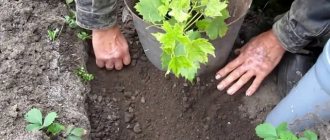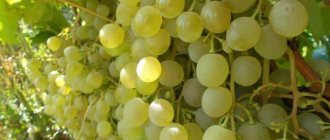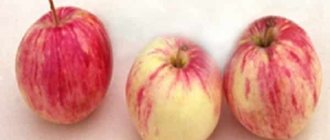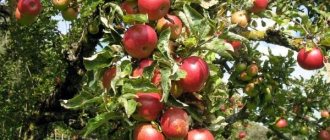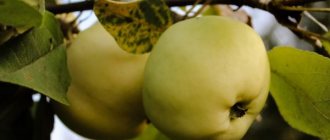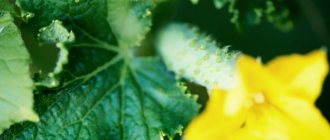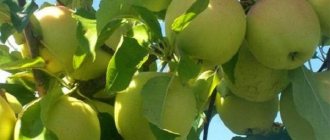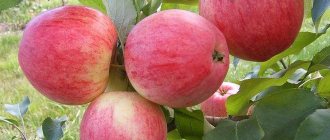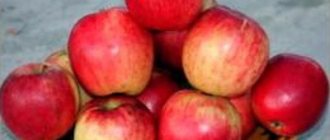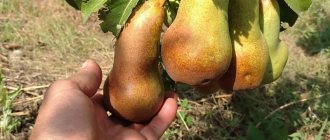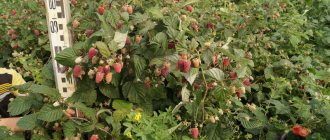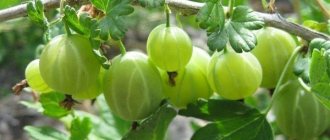Gardening » Apple tree
0
549
Article rating
Kira Stoletova
The apple tree is a popular and profitable garden crop. It grows quickly and produces a stable annual harvest. A variety is selected for a specific plot of land and soil composition. Thus, the Martovskoye apple tree is suitable for central Russia. The hybrid was bred from the Antonovka and McIntosh varieties.
Growing the March apple tree
Description
Winter apple trees of the Martovskoe variety were created at the Michurin Research Institute .
The genetic material for the creation was the Soviet standard of resistance - the well-known Antonovka vulgaris and the overseas variety McIntosh.
At the genetic level it is laid down:
- Excellent winter tolerance,
- Ability for long-term storage (5-6 months).
- The fruits are quite large , reaching a weight of up to 200g. The shape of the apples is round, the wide ribs are softly smoothed. The color of the fruit is yellow-green with a brownish-red blush, which turns even redder during storage.
They have excellent taste characteristics (4 points out of 5), sweet and sour taste, dense, juicy structure. Apples are most often used fresh, but they are also great for processing.
Trees are grown on different types of rootstocks.
The main production is tall, early-fruiting, unpretentious trees that grow quickly and are easy to form.
The variety is distributed in various regions of Russia, Belarus, Ukraine and the Baltic republics.
History of selection
This variety was bred at the Research Institute named after. Michurin, in 1971. The development of this variety was carried out by Z.I. Ivanova, S.I. Isaeva, G.A. Lobanova.
Apple trees of the Mackintosh and Antonovka varieties were taken as a basis. The apple tree of the Antonovka variety acted as the mother tree. Trees over 10 years old were selected for crossing .
18 trees were subjected to initial pollination 11 most successful trees for re-pollination
After successful pollination again, the breeders received seeds of a new variety. Later, after undergoing mandatory stratification, these seeds were planted.
The development of the new variety was stable, and during its further development the mentor’s technique was used. The variety was hardened under difficult climatic conditions.
additional characteristics
Advantages and disadvantages
March apple tree.
Among the main advantages are good yields with high marketability of fruits (90 - 92%):
- Apples have high keeping quality and transportability.
- The trees have good winter hardiness and drought resistance.
The disadvantages of the variety are:
- Difficult to maintain high crown,
- Insufficient resistance to scab and other fungal diseases.
Important! Uneven ripening of fruits does not allow the entire harvest to be harvested at the same time, since unripe fruits are poorly stored.
Dimensions of an adult tree
The Martovskoye apple tree is tall , provides large annual growth and reaches a height of 6-7 meters.
The crown of the tree is wide, oval-truncated or pyramidal.
The main skeletal branches are located almost perpendicular to the tree trunk, and the second-order branches extend upward at an acute angle.
Frequency of fruiting
Young apple trees produce a bountiful harvest every year. With age, a less pronounced periodicity of fruiting appears.
Productivity
The average yield of adult plants is 100 c/ha, and the highest is 220 c/ha . At the age of ten, one tree provides a yield of at least 100 kg of apples.
Tasting assessment
It has good tasting characteristics with a score of 4.2 points:
- dessert type variety , sweet and sour with a sugar content of at least 11.7 mg per 100 g.
- It has a high content of ascorbic acid (17.6 mg/100g), P - active elements and titratable acids.
- The variety is good not only for fresh use, but also for all types of processing.
Attention! The main direction of processing is the production of juices, since the fruits give a juice yield of up to 65%. At the same time, Martovsky’s juice is much sweeter than Antonovka’s.
Winter hardiness
It has good resistance to low temperatures, which is inherent at the genetic level .
In severe winters, slight freezing is possible.
After pruning damaged areas, trees are able to quickly recover .
Disease resistance
Disease resistance assessed as average (3.7 points):
- In dry climates, the risk of disease spread is low.
- However, in conditions of rainy, cool weather, diseases spread quickly and affect leaves and fruits, which significantly worsens marketability.
Pros and cons of the variety
Like every variety, the Martovskaya apple tree has its own positive and negative characteristics.
The positive ones include:
- productivity;
- resistance to harsh climates;
- drought resistance;
- keeping quality and transportability.
Disadvantages of the variety:
- low immunity to scab;
- unfriendly fruit ripening;
- unripe crops are not suitable for long-term storage;
- Due to the high growth, crown formation is difficult.
Reviews
Yaroslav . “An excellent variety for long-term storage. And what’s interesting is that over time the apples become redder and tastier.”
Anna. “ I have a Martovskoe apple tree on a dwarf rootstock, I bought it after seeing the description and photo. The harvest is excellent every year, we start using it before the new year, and it lasts until spring. We store it successfully in a cold cellar.”
Alexander. “ It’s a good variety, it fits well and the taste is excellent. Some claim that scab eats. Nonsense. No more than other varieties."
Nina. “ Simple preventive measures are enough to prevent apple trees from getting sick. But the result is excellent, tasty, especially pleasant in winter. I don’t regret that I trusted it when I studied the photo and description of the variety.”
Features of planting and care
Landing
Carrying out landing.
Deadlines
Depending on the weather conditions of the region, the optimal planting dates are:
- In spring - from March to mid-April,
- In autumn - from late September to mid-October.
Seedlings planted in the autumn should be able to gain a foothold in the ground before the onset of persistent frosts.
Spring planting is completed before the buds open. Delay in planting impairs the adaptation of trees and their survival rate.
Technology
Proper planting is the key to successful survival and future harvest:
- The size of the planting hole should significantly exceed the size of the root system of the seedling.
- Soil mixed with humus or well-rotted manure and mineral fertilizers is placed at the bottom Acidic soils are deoxidized with wood ash or dolomite flour. It is better not to apply nitrogen fertilizers before planting, especially in autumn.
- The root collar is not buried in the soil.
- Water the seedlings regularly until they are completely rooted.
Advice! Buy seedlings from trusted manufacturers and specialized nurseries.
Distance
requires a lot of space for good growth .
In addition, to maintain a large crown .
Planting scheme for trees on a vigorous rootstock 4x6m.
Growing
The most suitable apple trees for growing:
- Sandy loam;
- Loamy fertile soils.
As well as free, well-lit areas sheltered from the wind.
But the apple tree also grows in less favorable conditions; you will need to pay a little more attention to caring for the plant.
Important! The plant provides the highest yield on well-moistened soils.
Agricultural technology
Includes care and disease prevention work :
- Timely removal of weeds, plant debris, leaves and fallen fruits;
- Loosening and digging of tree trunk circles;
- Watering and fertilizing;
- Spraying against diseases and pests ;
- Removal of diseased and damaged fruits and branches;
- Whitewashing trunks and filling damaged areas with garden pitch.
Pruning and crown formation
Autumn pruning is carried out after the leaves fall , when foci of diseases and various damage to the bark become visible, in which fungal spores and garden pests will overwinter. The saw cuts must be sealed with garden pitch.
Pruning young trees.
In the spring, frozen, poorly overwintered branches and shoots that thicken the crown, directed into the crown and intersecting with each other, are pruned.
In order to form a crown, seedlings of the second year have their central stem cut off at a height above 70 cm, which promotes the development of lateral branches and the root system.
Pollinator varieties
Growing only Martovskoye apple trees in the garden will not allow you to reap a good harvest. Requires pollination by related varieties .
This role will be well fulfilled by:
- Sinap Northern,
- Bogatyr,
- Renet Chernenko.
Description of the apple variety Anis striped
Powerful hundred-year-old giants that still bear a lot of fruit often amaze foreign gardeners. Despite the small size of apples, as well as the insufficiently long shelf life, this Anise is recommended for growing in small garden plots, as well as in intensive commercial gardens.
Apples: what it looks like
The skin of the fruit is glossy, shiny, smooth, light green or light green in color; during ripening it is covered with an intense waxy coating, making the fruit bluish. The integumentary blush is speckled-striped, bright scarlet or simply red, occupying approximately 65-85% of the surface. Subcutaneous dots are light gray or greenish, large, few in number, and clearly visible. The easiest way to evaluate the chemical composition is by the following indicators:
- P-active substances (catechins) – 268 milligrams.
- Ascorbic acid (vitamin C) – 8.4 milligrams.
- Total sugars (fructose) – 11.5%.
- Pectins (fiber) – 14.8%.
- Titratable acids – 0.64%.
The pulp has a pleasant consistency, quite dense, fine-grained, and moderately juicy. It has an original, quite recognizable smell, as well as a sweet and sour taste, which is considered dessert, balanced and harmonious. The professional assessment of tasters for the Striped Anise (gray) variety is 4.6 points out of 5.
Apple tree Anise striped: characteristics
Crown and root system
The tree is considered medium-sized, although it can easily stretch up to 4.5-5 meters, and sometimes even more. However, most gardeners practice shaping to prevent excessive growth. The crown at a young age is cone-shaped, oval or broom-shaped, and tends to become very thick. The shoots are of medium thickness, geniculate, bent, covered with brown or brownish-brown bark, sometimes slightly pubescent. Fruits on ringlets and spears.
The leaves are medium-sized, round, elongated, leathery, dense, somewhat larger than those of Scarlet Anise. They are slightly shiny, although not glossy, have slight pubescence, a dark green or even emerald hue, with rough nervosa. The tips are long-pointed, the edges are finely serrated, crenate, and can be wavy. The root system is branched, quite powerful, of medium depth, and well adapted to searching for water.
Productivity and pollination
This subspecies of Anise, according to experts, is the most productive of all existing varieties.
The variety is considered conditionally self-fertile, which means that you will get some of the fruits even when there is not a single apple tree of another variety nearby that is suitable for flowering time. Bees and wind are enough for Anise, but it is better if there are such trees nearby. Then yields can be increased to the desired 100%. Many also recommend using mobile apiaries and spraying the garden with diluted honey or sugar during the flowering period.
Winter hardiness and disease resistance
All Anises react very adequately to fairly low temperatures. They do not show any special signs of freezing at temperatures of -37-40°C. But, even if the buds, young shoots or wood are damaged, the tree recovers very quickly and continues to bear fruit, as if nothing had happened. Therefore, the variety is very highly valued in particularly harsh regions, for example, in the Urals. But the tree cannot be grown in Siberia due to its height and the impossibility of sheltering for the winter.
Anise does not have immunity to powdery mildew, scab or other fungal infections. But their resistance is assessed by specialists at an average level; they are not prone to diseases, but can be affected by them. During the years of very strong epiphytoties, people get sick profusely and avalanche-like, so preventive measures must be carried out in a timely manner. The variety does not ignore insects, so insecticides should also always be in your arsenal.
There is a huge number of different subspecies of Anise, which are partially already described on our website. If they are not there yet, then similar material will be available soon. It is only worth saying that today there are many subvarieties that can be grown in the Far East, Siberia, the Urals, Tatarstan and Kazakhstan, Bashkiria and other regions that are no less difficult in terms of weather and climatic conditions. Striped anise is not yet suitable for these regions, but work with it is carried out constantly.
Features of ripening and fruiting
Fruiting
Start
The variety is tall , but develops quickly and is characterized by early fruiting.
At the age of 5 - 6 years, plants give a good harvest, and by the age of ten the yield is at least 100 kg.
Peculiarities
The fruits are distributed evenly over the crown and are laid both on the ringlets and on the fruit twigs.
Young plants are characterized by regular fruiting ; with age, a slight cyclicity appears.
Deadlines
Fruit ripening
Apples of the Martovskoe variety have an autumn ripening period ; they are ripe for picking by the end of September.
The ripeness of the fruits does not occur entirely evenly, so it is recommended to harvest them in several stages depending on the ripeness of the fruits.
Fruit storage
The apple variety got its name due to the fact that it is perfectly stored until March, without losing its merits and marketable qualities.
Under optimal storage conditions, the taste characteristics are improved and the juiciness is maintained.
Keeps well until March.
Diseases and pests
The discovery of pests on apple trees is primarily a consequence of improper care or lack thereof.
Current trend 2019-2020! Fashionable crop top dresses - photos, new items, ideas
To rid apple trees of pests, you need to know, first of all, which ones they are susceptible to:
- Green aphid. It is necessary to destroy the parasite's habitat, so one of the main measures will be to remove the damaged bark from the tree. Subsequently, you can spray the tree with a solution of chamomile infusion.
- Leaf roller. To defeat it, it is necessary to spray with a solution of karbofos.
- Apple moth. The main ally will be spraying the tree with chlorophos solution.
- Apple flower beetle. One of the most dangerous pests for the future harvest. To destroy it, you need to spray the tree with a solution of chlorophos or karbofos.
In terms of diseases, apple trees are quite resistant. But this stability may decrease due to improper care, unfavorable climatic conditions and other similar factors.
The most common diseases are:
- Black cancer. This disease occurs due to human fault. To destroy it, it is necessary to cut off damaged branches, disinfect, and heal wounds.
- Bacterial burn. To localize it, it is necessary to remove and disinfect the source of infection.
- Cytosporosis. To combat it before flowering, the tree must be treated with the drug “Hom”, and after flowering with a solution of copper sulfate.
- Scab. The best measure would be spraying with a urea solution.
- Powdery mildew. A widespread disease among young trees. To combat it, use a solution of colloidal sulfur.
- Fruit rot. The main control measure is to localize the outbreak; damaged fruits must be immediately removed from the tree.
The Martovskoye apple variety has become widespread due to the qualities of its fruits.
Its unpretentiousness in cultivation, excellent taste of the fruit, long shelf life and good transport tolerance make it an ideal industrial variety.
In households, it will appeal to those who like to eat apples all winter.
Subspecies and options
On a dwarf rootstock
Grafting onto a dwarf rootstock allows you to preserve the advantages of the variety and greatly facilitate maintenance.
In this case, the beginning of fruiting begins already in the second or third year after planting. And although an apple tree on a dwarf rootstock produces fewer fruits per tree than a tall one, efficiency is ensured by planting density and reduced harvesting costs.
Advice! A sufficient distance between apple trees when planting is 3 m.
Among the disadvantages of low-growing apple trees are fragility and lower resistance to adverse weather conditions.
Columnar
A distinctive feature of columnar trees is the absence of lateral shoots in the crown. In this case, the crown is the trunk on which the fruits are attached to the stalks.
They begin to bear fruit in the second or third year. Easy to maintain , practically do not require crown formation.
To establish a garden of columnar trees, the cost of planting material is high and an irrigation system is required, especially in the southern regions.
Planting several apple trees in the garden near the house does not require much space; they can be used to create a hedge or hide minor landscape flaws.
Interesting! The distance between apple trees on a dwarf rootstock can be no more than 60 cm, on a vigorous one - 1.2 m.
The disadvantage is a short lifespan and sensitivity to adverse environmental influences.
Disembarkation
The Martovskoye apple tree variety is planted according to a certain pattern. Trees are grafted in open ground as follows:
- preparation for planting takes at least 2-3 weeks;
- select the most illuminated and spacious plot of land;
- clean the soil, prepare a planting hole;
- At the same time, the young tree is being prepared;
- The apple tree is planted in one day, after which it is watered abundantly;
- Basic care for a young tree begins 2-3 weeks after planting;
- The first feeding is carried out no earlier than 2-3 years of the apple tree’s life.
The tree grows quickly and develops lateral branches, especially the dwarf subspecies. Biennial materials are used for such purposes. They not only grow faster, but are also more resistant to adverse environmental conditions.
For planting, choose planting material with a large root system. The more roots, the faster the tree will grow. The leaves formed on the shoot are a sign that the apple tree has not taken root well. It's better not to buy such material.
The grafting guarantees protection for the seedling: to check it, you need to carefully pull one root. If it comes off easily, the tree is not grafted correctly. A flexible and strong root system indicates suitable planting material.
Cactus aporocactus Home care Growing conditions Reproduction Photos of species
Deadlines
Planting can be done in spring and autumn.
Seedlings are planted in spring and autumn. Neither hot summer nor cold winter are suitable for such purposes. In order for the soil to become a favorable environment for trees, it is necessary to monitor warming. In spring, this period will be May. In most regions, the soil is already warming up by this time.
The buds on neighboring crops have not yet bloomed. Planting is carried out on a dry day. In order not to miscalculate the date, a hole for the tree with all its contents is prepared in the fall.
In the fall, the Martovskoe apple tree is planted before temperatures drop. The colder the soil, the more difficult it is for the seedling to take root. First of all, the gardener harvests the crop and only then creates a planting hole - at least 2 weeks must pass from the day of its creation to the day of planting.
In both cases, the seedling needs watering and protection from the wind. In September, when planting is usually done, mulching should be done. With the help of hay, grass and peat, the root system of planting material is protected.
Scheme
The planting hole must have certain dimensions. If you dig it too deep, groundwater will wash away the roots. As a result, the tree will lose nutrients - the trunk will be depleted, and the leaves will quickly fall off.
If the hole is too small, the roots will not have room to grow. The height of the tree in such conditions is minimal. For the Martovskoye variety, a hole is needed with a depth of 70-80 cm and a diameter of at least 80-90 cm. If the selected seedling has a dwarf rootstock, the size of the hole should be 10 cm smaller.
Immediately choose the distance between the crops - the closer the trees are to each other, the less sunlight will fall on the fruits. As a result, the harvest will be uneven and tasteless.
Fertilizers are added to the hole 2-3 weeks before planting. The mixture penetrates the soil and gradually nourishes the planting material every month. Due to the composition of the pit, the first feeding occurs no earlier than the second year. Choose manure and mineral fertilizers.
Compost gives a good effect. If the soil of the land is acidic, add wood ash and dolomite flour.
During planting, the gardener leaves a root collar above the soil layer. He carefully pours fresh soil and immediately waters it. To protect the young seedling, you can make a roller from the remaining soil. It will hold water near the trunk.
Growing in regions
In outskirts of Moscow
The conditions of the region are favorable for cultivating the variety on all types of rootstock. The variety's agricultural technology is traditional and does not require special measures.
In Siberia
Warming an apple tree.
Particular attention should be paid to insulating trees in a young garden for the winter. The tree trunk circles are mulched with sawdust, shavings, and humus.
The trunks are insulated with spruce branches and covering material.
In the Urals
The level of frost resistance allows the variety to winter safely in the region and ensure good yield.
Plants need to be supported by fertilizing with mineral and organic fertilizers.
In North-West Russia
In conditions of rainy, cool weather, there is a high risk of developing scab and other fungal diseases , so timely implementation of chemical treatments and preventive measures is the key to a successful harvest.
